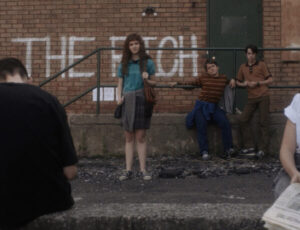Leos Carax’s Holy Motors is a paean to cinema itself, an elegiac yet energetic drive across genres to a terminal destination that hints that the oft-heralded ‘death of film’ at the hands of the digital revolution will bring not the end of this centuries-old art form, but an unfathomable transformation. And while the film’s performing this thematic feat, it becomes a vehicle for its star, French actor Denis Lavant, to go on a surreal odyssey that showcases his own remarkable range, as well as that of his medium and profession. It makes a tragic hero of the actor, but never in a self-congratulatory way; rather, it posits Lavant’s identity-shifting ‘character’ Oscar as an actor in the purest sense, doomed to live out humanity’s endless, astounding variety in Sisyphean fashion. We see but a glimpse of Oscar’s strange chameleonate life, but what a varied and perplexing glimpse it is–blessed with a magnificent performance by Lavant as his onscreen avatar assumes eleven different lives over the course of a day, each heralding stylistic shifts into different genres and modes of cinema that nonetheless maintain a consistent quality of paradoxically playful melancholy.
The result is a celebration of film as a medium—there is no plot, just radical transformations undertaken by Lavant as he slips seamlessly from one to another of his “appointments,” chauffeured around Paris in a limousine that also functions as a dressing room by driver Céline (Edith Scob). This makes for a film of narrative impenetrability, leaving the meaning underlying its indelible imagery entirely open to interpretation. There’s no singular way to read a dance between Lavant and an unnamed woman in a motion capture studio, their contortions morphing into CGI sex between demons in a pit; or Oscar as feral, gnomish sewer-dweller Merde, resting naked and graphically tumescent in the lap of his kidnapping victim, implacable model Kay M (Eva Mendes), as she sings him to sleep in the subterranean light beneath a cemetery; or Oscar doubled into identical versions of the same person; assassin and victim, become assassin and assassin.
There is some effort made to place these disparate vignettes within the context of a larger, self-contained world, though one that’s only tantalizingly hinted at. A representative of the “Agency” Oscar works for visits him at one point, asking whether Oscar is tired of his job. To which Oscar answers with the lament that “you can’t see [the cameras] at all” anymore, making it “hard to believe in it all,” a seeming indictment of our new media culture’s constant processing of images and information into an eternal cascade of ‘content’ to be consumed, of the diffusion of cinema and stories into feeds to be streamed and downloaded and tweeted and conjured onto phones instead of just projected onto the wall of a darkened theatre. But there is nothing so dourly didactic or Luddite in Carax’s mad vision, even if there is this foreboding of the future. In a telling moment, Oscar dreams of the limousine driving through a cemetery filled with the moans of unseen dead, while the picture onscreen decays into digital corruption, pixellating and tearing into a terrifying, multicoloured mud of entropy all too familiar to anyone who’s seen digital video skip for a moment. But what to make of this?
For all its subtext about the machinery of cinema vanishing until reality becomes indistinguishable for art, perhaps killing the need for art, there is still a powerful recognition of the beauty of this evolution, as in the MOCAP dance. This is too delirious a movie to be truly mournful. After all, there is no death in this world; Oscar dies more than once, only to rise again as a new person. Indeed, by the end, we’re not sure if Oscar exists at all anymore, whether he is purely defined by the myriad of people he plays, whether he’s literally a ghost in the machine of this cinematic reality. He and his fellow actors are like so many gods of artifice wandering the streets of Paris in their white limousines, given form and flesh by their worshipers/viewers.
This makes Holy Motors ultimately a speculative, or science fiction film, since it deals in a futurist scenario where actors live out endless roles to appease a mysterious viewership that craves human stories in perpetuity. But any literal interpretation of the film would snuff out its mysterious, infinite potential as a fever dream, dreamed by a mechanical demiurge on the eve of its symbolic death and physical evolution into a digital imago of its previous self. Oscar is a tired embodiment of cinema itself as it relives its many possible avatars. What lingers after the credits roll is the fierce wonder at the chimera that is human art, a shape-shifting trickster collectively brought to life by creator and consumer alike; the curiosity at this unending ritual of having surrogates act out human lives so that we can watch them, and care about them as we do real people. When Oscar’s possibly ‘real’ ex-lover Eva (Kylie Minogue) jumps to her death as her character Jean, do we not hope that this death is not real in the world of the movie, even though we know that it isn’t real anyway, that we are the ones that decide whether it is or isn’t in the movie? The contemplative possibilities are endless. I think the ultimate comfort for Carax here is that humans remain, no matter the medium or the machine that records our dances of artifice. Which is why Lavant’s bodily presence dominates the film, with each performance defined by the way he moves and breathes and speaks, infusing it with a joy at the malleability of the human identity. As long as the human remains in the machinery of cinema, its life remains also. But regardless of the thematic hall of mirrors presented by Holy Motors, rest assured that it is a wildly entertaining, exhilarating affirmation of the very act of placing one’s body in the seat of a movie theatre.








